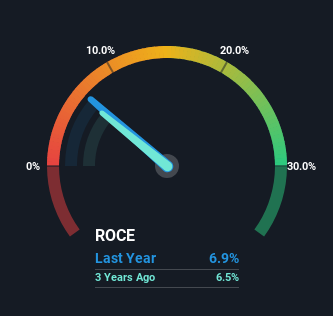- South Korea
- /
- Food
- /
- KOSDAQ:A005670
Some Investors May Be Worried About FOODWELL's (KOSDAQ:005670) Returns On Capital

If you're looking for a multi-bagger, there's a few things to keep an eye out for. Firstly, we'd want to identify a growing return on capital employed (ROCE) and then alongside that, an ever-increasing base of capital employed. Basically this means that a company has profitable initiatives that it can continue to reinvest in, which is a trait of a compounding machine. However, after investigating FOODWELL (KOSDAQ:005670), we don't think it's current trends fit the mold of a multi-bagger.
What Is Return On Capital Employed (ROCE)?
For those that aren't sure what ROCE is, it measures the amount of pre-tax profits a company can generate from the capital employed in its business. Analysts use this formula to calculate it for FOODWELL:
Return on Capital Employed = Earnings Before Interest and Tax (EBIT) ÷ (Total Assets - Current Liabilities)
0.069 = ₩9.8b ÷ (₩223b - ₩80b) (Based on the trailing twelve months to March 2024).
So, FOODWELL has an ROCE of 6.9%. Even though it's in line with the industry average of 7.1%, it's still a low return by itself.
See our latest analysis for FOODWELL

Historical performance is a great place to start when researching a stock so above you can see the gauge for FOODWELL's ROCE against it's prior returns. If you're interested in investigating FOODWELL's past further, check out this free graph covering FOODWELL's past earnings, revenue and cash flow.
How Are Returns Trending?
On the surface, the trend of ROCE at FOODWELL doesn't inspire confidence. Over the last five years, returns on capital have decreased to 6.9% from 13% five years ago. Although, given both revenue and the amount of assets employed in the business have increased, it could suggest the company is investing in growth, and the extra capital has led to a short-term reduction in ROCE. And if the increased capital generates additional returns, the business, and thus shareholders, will benefit in the long run.
On a side note, FOODWELL has done well to pay down its current liabilities to 36% of total assets. So we could link some of this to the decrease in ROCE. Effectively this means their suppliers or short-term creditors are funding less of the business, which reduces some elements of risk. Since the business is basically funding more of its operations with it's own money, you could argue this has made the business less efficient at generating ROCE.
In Conclusion...
While returns have fallen for FOODWELL in recent times, we're encouraged to see that sales are growing and that the business is reinvesting in its operations. These growth trends haven't led to growth returns though, since the stock has fallen 10% over the last five years. As a result, we'd recommend researching this stock further to uncover what other fundamentals of the business can show us.
On a final note, we found 5 warning signs for FOODWELL (1 makes us a bit uncomfortable) you should be aware of.
While FOODWELL isn't earning the highest return, check out this free list of companies that are earning high returns on equity with solid balance sheets.
New: AI Stock Screener & Alerts
Our new AI Stock Screener scans the market every day to uncover opportunities.
• Dividend Powerhouses (3%+ Yield)
• Undervalued Small Caps with Insider Buying
• High growth Tech and AI Companies
Or build your own from over 50 metrics.
Have feedback on this article? Concerned about the content? Get in touch with us directly. Alternatively, email editorial-team (at) simplywallst.com.
This article by Simply Wall St is general in nature. We provide commentary based on historical data and analyst forecasts only using an unbiased methodology and our articles are not intended to be financial advice. It does not constitute a recommendation to buy or sell any stock, and does not take account of your objectives, or your financial situation. We aim to bring you long-term focused analysis driven by fundamental data. Note that our analysis may not factor in the latest price-sensitive company announcements or qualitative material. Simply Wall St has no position in any stocks mentioned.
Have feedback on this article? Concerned about the content? Get in touch with us directly. Alternatively, email editorial-team@simplywallst.com
About KOSDAQ:A005670
FOODWELL
Engages in storing and processing agricultural products in South Korea.
Good value with adequate balance sheet.
Market Insights
Community Narratives




